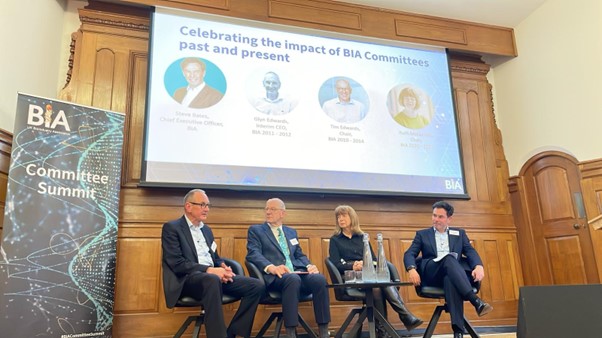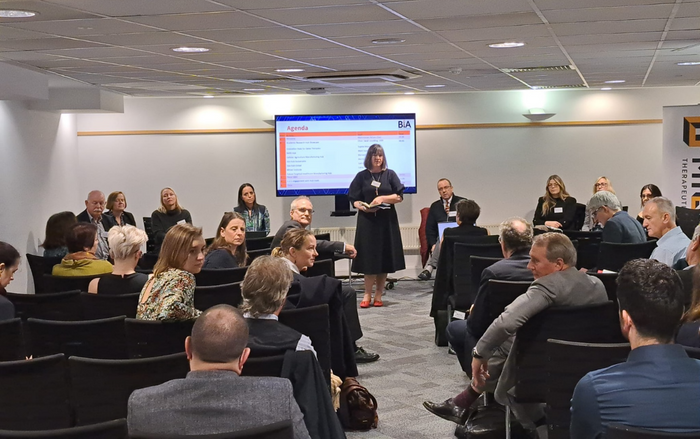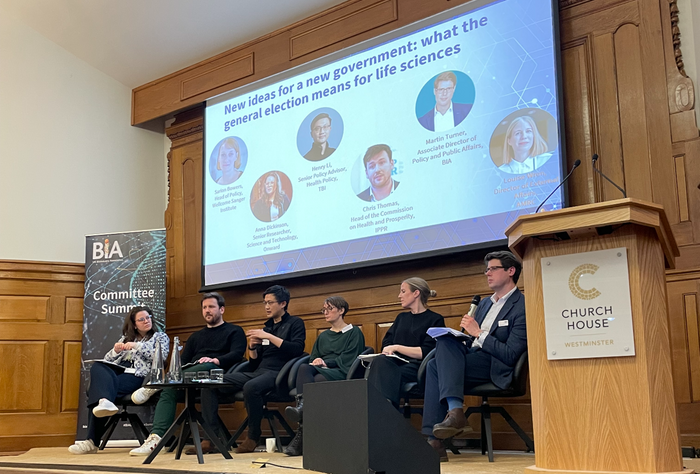Reflections on the BIA Committee Summit 2024

Herbie Lambden, Senior Policy and Public Affairs Executive at the BIA, provides a rundown of the BIA Committee Summit, which took place in Westminster on 21 February.
It was a pleasure to welcome our seven Advisory Committees back to Church House last week for the BIA’s annual Committee Summit, bringing together nearly 200 members of the BIA community for a day of collaboration, cross-pollination, and information sharing.
Each Committee hosted its first quarterly meeting of the year at the summit, generating a great buzz which was multiplied by the presence of observers from fellow Committees in the room.
The first of our two plenary sessions looked inward at the BIA, considering the historic impact of the Committees, whilst the second invited ‘new ideas for a new government’ from a stellar panel of policy experts. And what better place than the heart of SW1 to reflect on what 2024 might hold?
BIA past
Our first plenary invited an esteemed panel to reflect on the BIA’s vision for the sector published in 2015, asking what our Committees have achieved over the past decade and how can we apply lessons learned to the next.

(L-R) Glyn Edwards, Tim Edwards, Ruth McKernan, and Steve Bates discussing 'the impact of BIA Committees past and present' in our first plenary session.
Chaired by Steve Bates, we put this question to three alumni of the BIA - Ruth McKernan (Chair 2021-2022), Tim Edwards (Chair 2010-2014), and Glyn Edwards (Board member 2000-2009 and interim CEO 2011-2012).
There was no shortage of examples of BIA impact for panellists to point to, but it was the instrumental role played by our Cell and Gene Therapy Advisory Committee (CGTAC) that stood out to me. Tim Edwards explained how the Committee had been instrumental in making the case for the Cell and Gene Therapy Catapult, which was established in 2012 with Tim as an early Non-Executive Director. In just ten years, the modality has gone from one widely disregarded to a key UK strength delivering life-changing treatments for patients worldwide, as highlighted in a recent report from the BIA.
Picking winners is always difficult, so asking panellists to predict which of the BIA’s areas might be the next cell and gene was a tad cruel. The increasing breadth of our membership, though, has brought exciting new fields like TechBio and Deep Biotech into the fold, both of which were recognised to have game-changing potential.
BIA present
If the first plenary ran any risk of indulging in nostalgia, the Advisory Committee meetings most certainly did not. Committees used the summit to set out their work plans for the year, which were also presented to the Board. The lifeblood of the BIA, these sessions were as lively as ever.

A morning academic research hub showcase led by the Science & Innovation Community (SICom)
The raison d’être of the summit is to encourage Committee members to observe their counterparts’ meetings, fostering collaboration and awareness. This cross-pollination was in full swing this year, with dozens of observers in each session, including members of the Board.
We also drew in external speakers from the Office for Life Sciences, the MHRA, and Cancer Research UK, making this an ecosystem-spanning event.
BIA future
Our second plenary turned to the future, asking ‘what the general election means for life sciences’. The likelihood of a new government taking the reins this year opens the door to a new phase of policymaking for the life science sector and one that BIA members should feed into.

(L-R) Anna Dickinson (Onward), Chris Thomas (IPPR), Henry Li (TBI), Sarion Bowers (Wellcome Sanger), Louise Wren (AMRC), Martin Turner (BIA) speaking on our 'new ideas for a new government' panel
We invited an expert panel from beyond the industry to get a sense of what these ‘new ideas’ might be. From rewiring government to give the Department for Science greater control over spending to fixing our immigration system for skilled scientists and focusing on prevention to reduce health inequality, there was no shortage of possibilities for BIA Committee members to consider. The key theme, however, was one of alignment: our ecosystem speaks with one voice about the policy levers which most need to be pulled.
An important addendum came with panellists’ discussion of how we communicate science policy and why our sector merits government support. The ‘Discovery Decade’ project led by the Campaign for Science and Engineering (CaSE) was identified as an important resource for shaping our engagement with the public. In this election year more than ever, let’s think about what our sector means to the public in terms of jobs, growth, and life-changing innovation.
Crucially, it is you, the membership, who will steer our policy development through the coming months, whether through Committee meetings, contributions to consultation responses, or ad hoc meetings throughout the year.
.png)
.png)